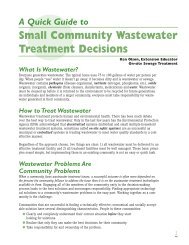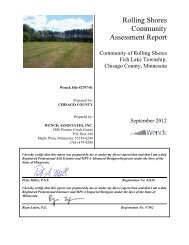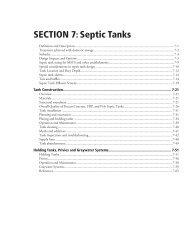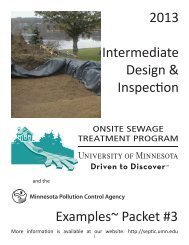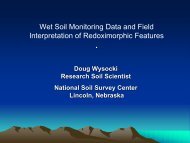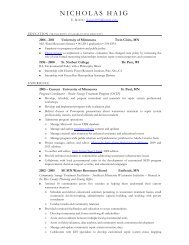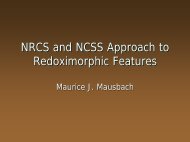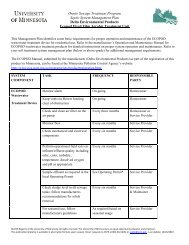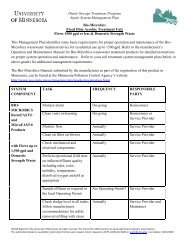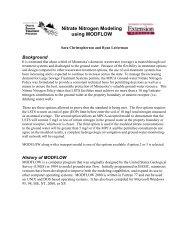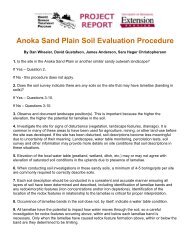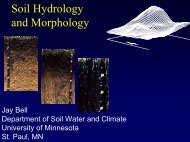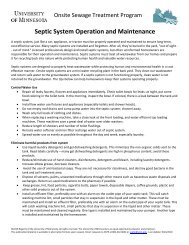MPCA Design Guidance for Large Subsurface Wastewater ...
MPCA Design Guidance for Large Subsurface Wastewater ...
MPCA Design Guidance for Large Subsurface Wastewater ...
You also want an ePaper? Increase the reach of your titles
YUMPU automatically turns print PDFs into web optimized ePapers that Google loves.
Refer to Attachment 8 <strong>for</strong> specific in<strong>for</strong>mation on methods to determine phosphorus attenuation. Also,<br />
submit a work plan that outlines the phosphorus attenuation discussed in the above paragraph to the<br />
<strong>MPCA</strong>.<br />
9. Hydrogeologic evaluation<br />
The Board of Architecture, Engineering, Land Surveying, Landscape Architecture, Geoscience and<br />
Interior <strong>Design</strong> (AELSLAGID) requires the use of professional geologists (PG) that are hydrogeologists<br />
<strong>for</strong> this portion of the review.<br />
Complete a thorough hydrogeologic evaluation of the site and submit the findings of that evaluation to<br />
the <strong>MPCA</strong> as a report. The <strong>MPCA</strong> staff should be contacted to discuss the project be<strong>for</strong>e beginning the<br />
hydrogeologic evaluation.<br />
The purpose of a hydrogeologic evaluation is to:<br />
1) Estimate the height of the ground water mound above the saturated zone and/or the height that<br />
effluent may perch over an unsaturated restrictive layer. It may be necessary that this<br />
assessment also include a determination of the potential <strong>for</strong> sideslope break-out (seepage) due to<br />
mounding or perching of effluent. The evaluation of mounding/perching is necessary <strong>for</strong> all<br />
proposed LSTS systems.<br />
2) Estimate the concentration of nitrate-nitrogen at the LSTS property boundary. This evaluation is<br />
only necessary <strong>for</strong> LSTS systems that choose Permitting Option 2 (see Section 6 <strong>for</strong> the<br />
definition of Option 2.)<br />
In<strong>for</strong>mation that will be collected and evaluated from the hydrogeologic evaluation includes:<br />
• the direction of ground water flow<br />
• the depth to the static ground water level<br />
• the rate of ground water movement (hydraulic conductivity)<br />
• the hydraulic gradient<br />
• the specific yield<br />
• geologic cross-sectional analysis of the site, including the presence of deeper limiting layers,<br />
water table surface, perched water tables, bedrock, karst, etc.<br />
• characterization of aquifers that may be impacted by the wastewater and whether the impacted<br />
aquifer is connected to a current or future drinking water aquifer<br />
• thickness of the saturated zone<br />
• background ground water quality data<br />
The items above involve hydrogeologic field work operations. This field work involves the drilling of<br />
deep borings at the proposed site followed by an evaluation of the bore holes and excavated material.<br />
The borings, and subsequently installed wells or piezometers, are used to test <strong>for</strong> the direction of ground<br />
water flow, the static water level, the hydraulic conductivity, the hydraulic gradient, saturated thickness,<br />
and the specific yield.<br />
The sixth bulleted item, geologic cross-sections, involves field work to create boring logs using the<br />
Unified Soil Classification System (USCS) method, and then office work creating two- or threedimensional<br />
profiles. To use the borings to determine ground water quality (including total nitrogen<br />
levels), the LSTS designer will be required to convert some or all of the borings to ground water wells to<br />
collect ambient ground water chemistry samples. This step will only have to be done if Permitting<br />
Option 2 from Section 5 – Nitrate-Nitrogen Treatment is chosen.<br />
If Permitting Option 2 is selected, use this ground water in<strong>for</strong>mation in the nitrogen model provided in<br />
this section or other contaminant dispersion model. Based on the results of the modeling, some of the<br />
<strong>Design</strong> <strong>Guidance</strong> <strong>for</strong> <strong>Large</strong> <strong>Subsurface</strong><br />
Minnesota Pollution Control Agency<br />
<strong>Wastewater</strong> Treatment Systems April 2010<br />
15



